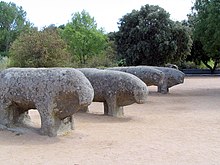



The verracos (Spanish: verraco; Portuguese: berrão; literally 'boar'), in the Iberian Peninsula, are the Vettones's granite megalithic monuments, sculptures of animals as found in the west of the Iberian meseta – the high central plain of the Iberian peninsula – in the Spanish provinces of Ávila, Salamanca, Segovia, Zamora, Cáceres, Ourense and the Portuguese provinces of Beira Baixa, Beiras e Serra da Estrela, Douro and Terras de Trás-os-Montes. Over 400 verracos have been identified.
The Spanish word verraco normally refers to boars, and the sculptures are sometimes called verracos de piedra (pigs of stone) to distinguish them from live animals. The stone verracos appear to represent not only pigs but also other animals. Some have been identified as bulls, and the village of El Oso, Ávila, named for "the Bear", has a verraco which supposedly represents a bear. Their dates range from the mid-fourth to first centuries BC. There are some similar zoomorphic monument markers in lands of Poland from the same period or older. [1]
Though they were perhaps not confined to a single usage, the verracos were an essential part of the landscape of the Vettones, one of the Pre-Roman peoples of the Iberian Peninsula. It has generally been assumed, from their high visibility in their original open fields surroundings, that these sculptures had some protective religious significance, whether guarding the security of livestock or as funerary monuments (some of them bear Latin funerary inscriptions). The verracos are particularly numerous too in the vicinity of the walled Celtiberian communities that Romans had called oppida.






{{cite book}}: CS1 maint: location missing publisher (link)
|
| |||||||
|---|---|---|---|---|---|---|---|
| Aquitani (Proto-Basques) |
| ||||||
| Iberians |
| ||||||
| Celts |
| ||||||
| Para-Celtic peoples? |
| ||||||
| Germanic peoples? |
| ||||||
| Greeks |
| ||||||
| Semitic peoples |
| ||||||
The Madeira, Azores, and Canary Islands were not occupied by the Romans. The Madeira and Azores islands were unoccupied until the Portuguese in the 15th century; the Canary islands, the Guanches occupied the territory until the Castilians. | |||||||